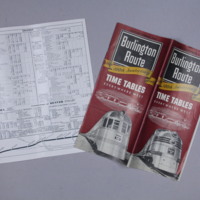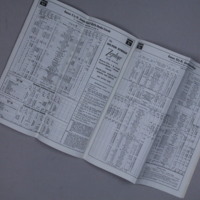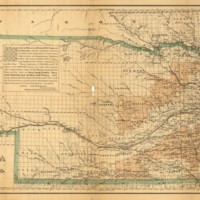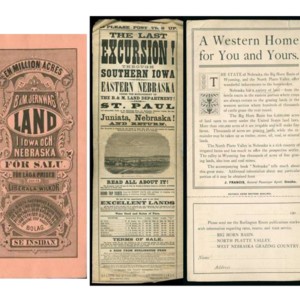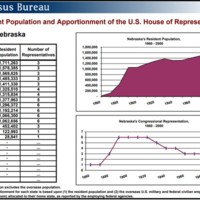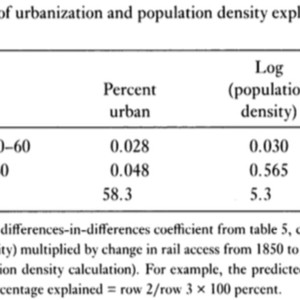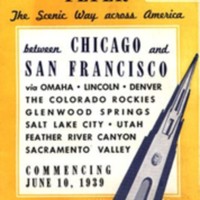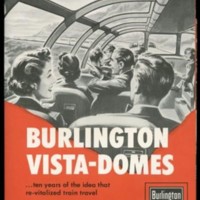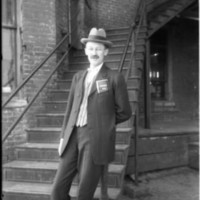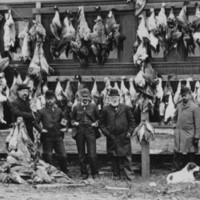Burlington Railroad Timetable
Title
Burlington Railroad Timetable
Subject
Railroads shrunk space and time during the nineteenth century. Before the growth of railroad networks, a trip from Chicago to Omaha took 5 days. By the twentieth century, railroads companies like the Burlington cut that time down to 8 hours. This was an important transition because railroads opened up new markets, new resources, and new environments to places like Omaha. As networks of railroads expanded, they created unified timetables which regulated time. This timetable, printed during the twilight of this railroad age, is symbol of this global transition. By the mid-twentieth century, railroads like the Burlington connected Omaha to the rest of America by encouraging economic growth and ecotourism.
Description
The railroad timetable annihilated time and space. It was America’s first-time keeper, and changed how people around the world considered travel. As intricate networks of railroads stretched across countries around the world, they introduced an era where distances were easily conquerable. People and goods were transported to the far reaches of countries. More importantly, the railroads brought with them timetables. The condensed pamphlets of arrivals and departures established a means of organizing time across the expanses the railroads covered. As railroads expanded the timetables were a means to unify how the country experienced time.
Time is precious, and prior to the timetable there was no unified way of managing it. Towns prior to the railroad were limited in the amount of resources they had and had their own “temporal identities”. For example, London ran 4 minutes ahead of Reading, and 7 minutes and 30 seconds ahead of Cirencester, and a whole 15 minutes ahead of Bridgewater. (Schivelbusch, 1941) This system of localized time fared well prior to railroad due to the lack of travel and the long travel time between them. The main methods of transport in the 1800s were by boat through rivers and canals, or by carriage. These methods were not the most trust worthy and limited growth of cities to what they in their radius for the most part. The most striking issues was how slow and unreliable these methods of transport were. A fifteen-minute difference in time was not important if the time to travel to the area was measured in days. When railroads were introduced, traffic between cities increased and transit time shrunk. Railroad became an important mode of transport of goods and people. Resources once inaccessible to some towns were now easily shipped. Likewise, smaller towns grew into large cities by exporting their abundant good to other locations and gaining capital. A time difference between cities was longer plausible as it would mean confusion and inefficiency for the railroad and those who invested in it. Thus, the railroads implemented their own times and created timetables with them. Initially the time chosen was up to company, for example in 1871 the Central Pacific Railroad specified their timetable operated on Sacramento time, where its headquarters resided. (White, 2011) This allowed passengers to manage their time around a specific line, however it became inefficient when more than one train had to be taken. Having more than one time in a town also became inconvenient. In 1883, the United States officially standardized railroad time amongst all operating railroad companies, and people and businesses began to informally use it as a standard. (White, 2011) Timetables were a game changer for businesses and individuals alike.
Omaha’s history can be traced back to railroads. Though the Union Pacific Headquarters currently resides in Omaha, the Burlington was more involved with the cities growth. The Union Pacific Railroad cut through Nebraska, pursuing a transcontinental railroad which passed through the country more so than branching to connect cities with one another. Though initially hesitant to expand to Nebraska, by 1868 The Burlington company saw it as a business opportunity after Charles Elliott Perkin, who would later become President of the Burlington Railroad, gave it a glowing review. (Kinbacher and Thomas, 2008) The Burlington Railroad acted on the 1864 Pacific Railroad Act which authorized the construction of a trunk line passing though territory south of the Platte River to intersect with the Union Pacific transcontinental route at or near the 100th meridian. (Kinbacher and Thomas, 2008) By 1872, a whopping 2,400,000 acres of land in Nebraska was granted to the Burlington Railroad by the U.S government to begin building railroad (Figure 1). (Overton, 1976)
Thus, the Burlington Railroad threw open the doors to the West and ushered in a new wave of settlers. Initially upon receiving its land grants the Burlington launched an effort to sell it to prospective settlers. By successfully selling land around the area they use to build railroads up the Burlington increases the value of the railroad land they acquired. The Burlington was also granted more land due to its success in advertising the Midwest. (Overton, 1976) The Burlington created programs based on credit to sell the land around the railroads, and the area was advertised in the East though various exhibits, pamphlets, and maps. (O'Neil, 1956) A colonizing campaign was created and lured in potential settlers with special such as reduced prices for settlement (Figure 2). In addition, the Burlington shipped in resources required to build the city, and to jump start farming, while advertising Nebraska’s potential at agricultural fairs in both the US and England. (Fisher, 1931) Despite being in competition with Union Pacific, overall the Burlington sold more land to potential settlers and investors. (Kawashima, 2010)
These early promotional efforts were extremely effective and in time Nebraska became a well settled agricultural area. In 1872 alone, farmers shipped a quarter million bushels of wheat through across Burlington rail, and they were of such quality that the price easily paid for the cost of transportation. (Jones, 1957) The growth of the Burlington route, in a very real sense, both mirrored and prompted the growth of Nebraska, and Omaha. The growth of the city can be seen in census data. Though correlation does not mean causation, it is clear the growth of population in Nebraska coincided with the arrival of the Burlington Railroad (Graph 1 and Figure 3).
By the 1900s, the Burlington its veered away from cargo and shifting its focus to passenger transportation. (Dorin, 1976) This was a response to the booming Second Industrial Revolution which came with a new-found interest in leaving the cities to experience nature. The Burlington made began to advertise the new concept of ecotourism to cater to the new American desire to explore the West. Improvements in the 1930s to its passenger service increased revenue and provided an economic boost to the Omaha after the depression. (Overton, 1941) The Burlington advertised Omaha as a gateway to West and promoted their line as a comfortable, exciting mode of travel for tourists. The Burlington released new trains such as the Exposition Flyer in 1939 which traveled for decades due to their popularity as a scenic draw (Figure 4). This inspired the Burlington to create more trains to cater to a new generation of ecotourists. (Retzinger, 1998) The emphasis on passenger rail services increased into the 1940s.Their Zephyr line, which ran from 1935 to 1960 featured air conditioning, vista domes, and in cabin luxuries (Figure 5). The Burlington Railroad aimed to make travel West easy and compelling.
The growth of Omaha and Lincoln was undeniable, and correlated strongly with the establishment of the railroad. Atack et al. (2010), found a strong correlation between the expansion of railroads and the growth of cities. The Burlington Railroad created a network that connected almost everywhere in North America. Railroads even connected to seaports, which allowed for overseas transportation of commodities. (Milner, 1994) Atack et al. (2010) concluded that while the expansion of railroads did not have a significant enough correlation with population increase in the Midwest to be considered a cause of population growth, it was the most important factor behind urbanization in the Midwest. They cite three reasons as to why this is the case. First, railroads reduced the costs of transportation of goods, which led to increased trade. Second, they caused Midwestern wealth to increase which led to greater demand for industrial products. Lastly, they created “feeder lines”, which are connections between cities and towns, which encouraged people to settle into areas before railroads were constructed in those areas .
In his book Nature’s Metropolis, William Cronon (1991) discusses how trains helped to urbanize Chicago. He states that distance was not as important a factor as time and cost in transportation. Because trains can travel much faster than many other modes of transportation, they greatly increased transportation of goods between Chicago and the surrounding rural areas. He states that many people were eager to use this new form of transportation because of its great speed. Interestingly, he states that many inhabitants of Chicago at the time believed that railroads had become “assimilated” to the natural landscape of the area . Railways also helped build many other Western cities (Milner, II et al. 1994). Railroads also advanced agriculture through their transportation speed. For a while, Texas Longhorn cattle were plagued by a tick-borne disease known as Texas fever. The ticks thrived in Texas, but could not survive the colder winters of the North. Because of this, the cattle were sometimes held in shipped north to be fattened up until they had become of Texas fever. A man named Joseph McCoy was noted for taking advantage of this situation using the railroad systems. He, along with many others, established cattle towns, such as Abilene, Kansas, where he could supply Texas Cattle to the Kansas Pacific railroad. Shipping of beef became an important industry for trains, especially when refrigerated train cars made shipment much more efficient, as it kept the beef fresher for longer. Gustavus Swift pioneered the use of refrigerated railroad cars and began to sell beef from Chicago in New York.
Other agricultural products were shipped via trains, and railroad companies often encouraged farming near the railroad lines by providing economic incentives and some forms of compensation during periods of economic stress. Many of them encouraged dry-farming, which, as its name suggests, is farming pioneered by Hardy Webster Campbell that is productive in the dry environments of the northern Great Plains, in order to ensure that more farmers settled in. There were some people who accused railroad companies of exploiting the farmers. According to Milner, II et al. 1994, “along the rail system, farms sprang up like winter wheat in a Kansas spring.” As a result of the mass transportation of agricultural products brought about by trains, new opportunities opened up in industrial, urbanized areas, such as food processing plants and similar areas. (Milner, 1994)
In addition to facilitating urbanization, trains later also made it easier for city-dwellers to commodify nature in another way. By moving people to different parts of the country faster, they allowed people to consume distant environments through tourism (Figure 6). During the twentieth century, the western United States became a popular tourist destination, mainly because it contained much truer wilderness than the East due to less human disturbance. National parks were often advertised by railroads to promote tourism. Often the trains would take hundreds of tourists to one spot, and the tourists would then reach the parks on horseback. Tourism became more popular in the 1920s thanks to Hollywood, although cars began to gain more popularity in this era, so it is unclear whether the 1920s was a prosperous era for the railroad industry or not. Union Pacific opened a ski resort in Sun Valley, Idaho in the 1936, which gained more popularity after World War II. Railroads also made exploitation of game animals much more efficient. Bison, for example, suffered from the westward expansion of railroads, by allowing hunters to transport their bison kills to the markets much more easily than before . This was furthered by the invention of refrigerated cars. Railroad companies even hired bison hunters to provide meat to their workers as well as fill their freight cars with numerous possible commodities. “Buffalo Bill” actually claimed to have killed 4,280 bison for Union Pacific. Railroads transported not only hunters’ quarries more efficiently, but also transported the hunters themselves to their quarries more efficiently and quickly than before. Bison were even shot for sport from the windows of trains. (Dolin, 2003). It is said that the railroads, along with the telegraph, were the most important contributors to the extinction of the Passenger Pigeon (Figure 7). (Burke, 2017) After World War II, other modes of transportation, such as cars and airplanes slowly became more popular, leading to the gradual decline of railroad tourism. (Milner, 1994)
Omaha and its relationship with the Burlington railroad serves as a powerful example of the urbanizing power of railways and their impacts. The surrounding environment is both drained filled in with the human footprint, and thus its ecological changes become apparent. Trains drastically changed how people and businesses viewed transportation across vast distances. The Burlington timetable is a testament to how humans eliminated time as a constraining factor in the consumption and exploitation of new, distant, environments. Areas which were otherwise inaccessible without significant travel and hardship became easily accessible. Railroads facilitated the exploitation of nature by both bringing people to nature and bringing nature to people. They moved people seeking to urbanize to their cities, urban tourists to their scenic wilderness, and hunters to their quarry. In addition, they moved all kinds of natural resources from rural and wild areas into cities. This became the key to more urbanization and spreading of cities. More and more products of the area were shipped out and in demand, and more resources to fulfill that demand were shipped in. Resources included people who were ready to work, in addition to materials. The possibility for capital growth and success was increased significantly when railways were introduced to bring regions together to exchange resources. The ease of export also meant increased capital gains for those invested in the area and a drive utilize the earth for short term gain over long term upkeep. This sort of development lead to the ideas of Eugene Odum who observed cities as parasitic. This parasitic nature is only made possible by railways which act like extensive capillaries carrying capital, resources, and people one area to the next. This idea is further exemplified by the fact that many rural westerners felt that they were essentially a colony of the eastern urban elite, who drained the resources of the rural western United States for their own benefit. They often referred to the western United States as a “plundered province”. There were also many economic policies which favored easterners over westerners, such as tariffs. This led to some resentment of the East, whom the West often scapegoated for its problems, although, as noted before, sometimes rightfully so. (Milner, 1994) This situation prevails today, not just here in Omaha, but all over the world. The railroad, despite having given away to cars as the most popular means of transport, is still important for import of resources over long distance. The Burlington railroad left its footprint in Omaha, its headquarters taken over by KMTV still exist today. The crisscrossing of railroads correlated to the influx of people and capital which resulted in Omaha’s growth as a city.
Time is precious, and prior to the timetable there was no unified way of managing it. Towns prior to the railroad were limited in the amount of resources they had and had their own “temporal identities”. For example, London ran 4 minutes ahead of Reading, and 7 minutes and 30 seconds ahead of Cirencester, and a whole 15 minutes ahead of Bridgewater. (Schivelbusch, 1941) This system of localized time fared well prior to railroad due to the lack of travel and the long travel time between them. The main methods of transport in the 1800s were by boat through rivers and canals, or by carriage. These methods were not the most trust worthy and limited growth of cities to what they in their radius for the most part. The most striking issues was how slow and unreliable these methods of transport were. A fifteen-minute difference in time was not important if the time to travel to the area was measured in days. When railroads were introduced, traffic between cities increased and transit time shrunk. Railroad became an important mode of transport of goods and people. Resources once inaccessible to some towns were now easily shipped. Likewise, smaller towns grew into large cities by exporting their abundant good to other locations and gaining capital. A time difference between cities was longer plausible as it would mean confusion and inefficiency for the railroad and those who invested in it. Thus, the railroads implemented their own times and created timetables with them. Initially the time chosen was up to company, for example in 1871 the Central Pacific Railroad specified their timetable operated on Sacramento time, where its headquarters resided. (White, 2011) This allowed passengers to manage their time around a specific line, however it became inefficient when more than one train had to be taken. Having more than one time in a town also became inconvenient. In 1883, the United States officially standardized railroad time amongst all operating railroad companies, and people and businesses began to informally use it as a standard. (White, 2011) Timetables were a game changer for businesses and individuals alike.
Omaha’s history can be traced back to railroads. Though the Union Pacific Headquarters currently resides in Omaha, the Burlington was more involved with the cities growth. The Union Pacific Railroad cut through Nebraska, pursuing a transcontinental railroad which passed through the country more so than branching to connect cities with one another. Though initially hesitant to expand to Nebraska, by 1868 The Burlington company saw it as a business opportunity after Charles Elliott Perkin, who would later become President of the Burlington Railroad, gave it a glowing review. (Kinbacher and Thomas, 2008) The Burlington Railroad acted on the 1864 Pacific Railroad Act which authorized the construction of a trunk line passing though territory south of the Platte River to intersect with the Union Pacific transcontinental route at or near the 100th meridian. (Kinbacher and Thomas, 2008) By 1872, a whopping 2,400,000 acres of land in Nebraska was granted to the Burlington Railroad by the U.S government to begin building railroad (Figure 1). (Overton, 1976)
Thus, the Burlington Railroad threw open the doors to the West and ushered in a new wave of settlers. Initially upon receiving its land grants the Burlington launched an effort to sell it to prospective settlers. By successfully selling land around the area they use to build railroads up the Burlington increases the value of the railroad land they acquired. The Burlington was also granted more land due to its success in advertising the Midwest. (Overton, 1976) The Burlington created programs based on credit to sell the land around the railroads, and the area was advertised in the East though various exhibits, pamphlets, and maps. (O'Neil, 1956) A colonizing campaign was created and lured in potential settlers with special such as reduced prices for settlement (Figure 2). In addition, the Burlington shipped in resources required to build the city, and to jump start farming, while advertising Nebraska’s potential at agricultural fairs in both the US and England. (Fisher, 1931) Despite being in competition with Union Pacific, overall the Burlington sold more land to potential settlers and investors. (Kawashima, 2010)
These early promotional efforts were extremely effective and in time Nebraska became a well settled agricultural area. In 1872 alone, farmers shipped a quarter million bushels of wheat through across Burlington rail, and they were of such quality that the price easily paid for the cost of transportation. (Jones, 1957) The growth of the Burlington route, in a very real sense, both mirrored and prompted the growth of Nebraska, and Omaha. The growth of the city can be seen in census data. Though correlation does not mean causation, it is clear the growth of population in Nebraska coincided with the arrival of the Burlington Railroad (Graph 1 and Figure 3).
By the 1900s, the Burlington its veered away from cargo and shifting its focus to passenger transportation. (Dorin, 1976) This was a response to the booming Second Industrial Revolution which came with a new-found interest in leaving the cities to experience nature. The Burlington made began to advertise the new concept of ecotourism to cater to the new American desire to explore the West. Improvements in the 1930s to its passenger service increased revenue and provided an economic boost to the Omaha after the depression. (Overton, 1941) The Burlington advertised Omaha as a gateway to West and promoted their line as a comfortable, exciting mode of travel for tourists. The Burlington released new trains such as the Exposition Flyer in 1939 which traveled for decades due to their popularity as a scenic draw (Figure 4). This inspired the Burlington to create more trains to cater to a new generation of ecotourists. (Retzinger, 1998) The emphasis on passenger rail services increased into the 1940s.Their Zephyr line, which ran from 1935 to 1960 featured air conditioning, vista domes, and in cabin luxuries (Figure 5). The Burlington Railroad aimed to make travel West easy and compelling.
The growth of Omaha and Lincoln was undeniable, and correlated strongly with the establishment of the railroad. Atack et al. (2010), found a strong correlation between the expansion of railroads and the growth of cities. The Burlington Railroad created a network that connected almost everywhere in North America. Railroads even connected to seaports, which allowed for overseas transportation of commodities. (Milner, 1994) Atack et al. (2010) concluded that while the expansion of railroads did not have a significant enough correlation with population increase in the Midwest to be considered a cause of population growth, it was the most important factor behind urbanization in the Midwest. They cite three reasons as to why this is the case. First, railroads reduced the costs of transportation of goods, which led to increased trade. Second, they caused Midwestern wealth to increase which led to greater demand for industrial products. Lastly, they created “feeder lines”, which are connections between cities and towns, which encouraged people to settle into areas before railroads were constructed in those areas .
In his book Nature’s Metropolis, William Cronon (1991) discusses how trains helped to urbanize Chicago. He states that distance was not as important a factor as time and cost in transportation. Because trains can travel much faster than many other modes of transportation, they greatly increased transportation of goods between Chicago and the surrounding rural areas. He states that many people were eager to use this new form of transportation because of its great speed. Interestingly, he states that many inhabitants of Chicago at the time believed that railroads had become “assimilated” to the natural landscape of the area . Railways also helped build many other Western cities (Milner, II et al. 1994). Railroads also advanced agriculture through their transportation speed. For a while, Texas Longhorn cattle were plagued by a tick-borne disease known as Texas fever. The ticks thrived in Texas, but could not survive the colder winters of the North. Because of this, the cattle were sometimes held in shipped north to be fattened up until they had become of Texas fever. A man named Joseph McCoy was noted for taking advantage of this situation using the railroad systems. He, along with many others, established cattle towns, such as Abilene, Kansas, where he could supply Texas Cattle to the Kansas Pacific railroad. Shipping of beef became an important industry for trains, especially when refrigerated train cars made shipment much more efficient, as it kept the beef fresher for longer. Gustavus Swift pioneered the use of refrigerated railroad cars and began to sell beef from Chicago in New York.
Other agricultural products were shipped via trains, and railroad companies often encouraged farming near the railroad lines by providing economic incentives and some forms of compensation during periods of economic stress. Many of them encouraged dry-farming, which, as its name suggests, is farming pioneered by Hardy Webster Campbell that is productive in the dry environments of the northern Great Plains, in order to ensure that more farmers settled in. There were some people who accused railroad companies of exploiting the farmers. According to Milner, II et al. 1994, “along the rail system, farms sprang up like winter wheat in a Kansas spring.” As a result of the mass transportation of agricultural products brought about by trains, new opportunities opened up in industrial, urbanized areas, such as food processing plants and similar areas. (Milner, 1994)
In addition to facilitating urbanization, trains later also made it easier for city-dwellers to commodify nature in another way. By moving people to different parts of the country faster, they allowed people to consume distant environments through tourism (Figure 6). During the twentieth century, the western United States became a popular tourist destination, mainly because it contained much truer wilderness than the East due to less human disturbance. National parks were often advertised by railroads to promote tourism. Often the trains would take hundreds of tourists to one spot, and the tourists would then reach the parks on horseback. Tourism became more popular in the 1920s thanks to Hollywood, although cars began to gain more popularity in this era, so it is unclear whether the 1920s was a prosperous era for the railroad industry or not. Union Pacific opened a ski resort in Sun Valley, Idaho in the 1936, which gained more popularity after World War II. Railroads also made exploitation of game animals much more efficient. Bison, for example, suffered from the westward expansion of railroads, by allowing hunters to transport their bison kills to the markets much more easily than before . This was furthered by the invention of refrigerated cars. Railroad companies even hired bison hunters to provide meat to their workers as well as fill their freight cars with numerous possible commodities. “Buffalo Bill” actually claimed to have killed 4,280 bison for Union Pacific. Railroads transported not only hunters’ quarries more efficiently, but also transported the hunters themselves to their quarries more efficiently and quickly than before. Bison were even shot for sport from the windows of trains. (Dolin, 2003). It is said that the railroads, along with the telegraph, were the most important contributors to the extinction of the Passenger Pigeon (Figure 7). (Burke, 2017) After World War II, other modes of transportation, such as cars and airplanes slowly became more popular, leading to the gradual decline of railroad tourism. (Milner, 1994)
Omaha and its relationship with the Burlington railroad serves as a powerful example of the urbanizing power of railways and their impacts. The surrounding environment is both drained filled in with the human footprint, and thus its ecological changes become apparent. Trains drastically changed how people and businesses viewed transportation across vast distances. The Burlington timetable is a testament to how humans eliminated time as a constraining factor in the consumption and exploitation of new, distant, environments. Areas which were otherwise inaccessible without significant travel and hardship became easily accessible. Railroads facilitated the exploitation of nature by both bringing people to nature and bringing nature to people. They moved people seeking to urbanize to their cities, urban tourists to their scenic wilderness, and hunters to their quarry. In addition, they moved all kinds of natural resources from rural and wild areas into cities. This became the key to more urbanization and spreading of cities. More and more products of the area were shipped out and in demand, and more resources to fulfill that demand were shipped in. Resources included people who were ready to work, in addition to materials. The possibility for capital growth and success was increased significantly when railways were introduced to bring regions together to exchange resources. The ease of export also meant increased capital gains for those invested in the area and a drive utilize the earth for short term gain over long term upkeep. This sort of development lead to the ideas of Eugene Odum who observed cities as parasitic. This parasitic nature is only made possible by railways which act like extensive capillaries carrying capital, resources, and people one area to the next. This idea is further exemplified by the fact that many rural westerners felt that they were essentially a colony of the eastern urban elite, who drained the resources of the rural western United States for their own benefit. They often referred to the western United States as a “plundered province”. There were also many economic policies which favored easterners over westerners, such as tariffs. This led to some resentment of the East, whom the West often scapegoated for its problems, although, as noted before, sometimes rightfully so. (Milner, 1994) This situation prevails today, not just here in Omaha, but all over the world. The railroad, despite having given away to cars as the most popular means of transport, is still important for import of resources over long distance. The Burlington railroad left its footprint in Omaha, its headquarters taken over by KMTV still exist today. The crisscrossing of railroads correlated to the influx of people and capital which resulted in Omaha’s growth as a city.
Creator
John Brennan
Devika Prasanth
Devika Prasanth
Source
Atack, Jeremy, Fred Bateman, Michael Haines, and Robert A. Margo. “Did Railroads Induce or
Follow Economic Growth: Urbanization and Population Growth in the American
Midwest, 1850-1860.” Social Science History 34.2 (2010): 171-197. JSTOR. Web. 17
Oct. 2017.
Bostwick- Forhardt Collection, 1850-1964, compiled by The The Durham Museum (Omaha, Durham
Museum Photo Archive, 2017 ).
Burk, Theodore. Conservation Biology Lecture. 2017. Personal Communication.
Cronon, William. Nature's Metropolis: Chicago and Great West. New York: W·W·NORTON &
COMPANY, 1991. ebook.
Dolin, Eric Jay. Smithsonian Book of National Wildlife Refuges. Old Saybrook: Konecky &
Konecky, 2003. Print.
Fisher, Chas. E. "The Chicago, Burlington & Quincy Railroad Company." The Railway and
Locomotive Historical Society Bulletin, No 24 (1931): 4-43.
<http://www.jstor.org/stable/43516939>.
Jones, C. Clyde. "The Burlington Railroad and Agricultural Policy in the 1920's." Agricultural
History, Vol. 31, No. 4 (1957): 67-74.
Kawashima, Yasuhide. “Farmers, Ranchers, and the Railroad: The Evolution of Fence
Law in the Great Plains, 1865-1900.” Great Plains Quarterly 30.1 .2010.: 21-35.
JSTOR. Web. 7 Oct. 2017.
Kinbacher, Kurt E. and William G. Thomas III. "Shaping Nebraska An Analysis Of Railroad
And Land Sales, 1870-1880." Great Plains Quarterly 2008. <http://digitalcommons.unl.edu/cgi/viewcontent.cgi?article=2374&context=greatplainsquarterl>.
Loomis, Bill. Photograph. “Slaughtered to extinction: Passenger pigeons in Michigan.” The Detroit
News. MediaNews, 31 Aug. 2014. Web. 13 Dec. 2017.
Milner, II, Clyde A., Carol A. O’Connor, Martha A. Sandweiss, eds.. The Oxford History of the
American West. New York: Oxford University P., 1994. Print.
Olmanson, E. D. (n.d.). Promotion and Transformation of Landscapes along the CB&Q Railroad. Retrieved October, 2017, from http://www.environmentandsociety.org/exhibitions/railroad/settlement-promotion-burlington-railroad
Overton, Richard C. Burlington West: A Colonization History of the Burlington Railroad.
Cambridge: Harvard University Press, 1941.
Retzinger, Jean P.. “Framing the Tourist Gaze: Railway Journeys Across Nebraska, 1866-1906.”
Great Plains Quarterly 18.3 1998: 213-226. JSTOR. Web. 6 Oct. 2017.
Schivelbusch, W., Railroad Space and Railroad Time. In The Railway Journey : The Industrialization of Time and Space in the 19th Century. 1941. (pp. 33-44). Berkeley: University of California Press.
The California Zephyr. (n.d.). Retrieved December, 2017, from http://calzephyr.railfan.net/expoflyer.html
White, R. Railroaded: The Transcontinentals and the Making of Modern America. 2011. New York: W.W. Norton & Company
Follow Economic Growth: Urbanization and Population Growth in the American
Midwest, 1850-1860.” Social Science History 34.2 (2010): 171-197. JSTOR. Web. 17
Oct. 2017.
Bostwick- Forhardt Collection, 1850-1964, compiled by The The Durham Museum (Omaha, Durham
Museum Photo Archive, 2017 ).
Burk, Theodore. Conservation Biology Lecture. 2017. Personal Communication.
Cronon, William. Nature's Metropolis: Chicago and Great West. New York: W·W·NORTON &
COMPANY, 1991. ebook.
Dolin, Eric Jay. Smithsonian Book of National Wildlife Refuges. Old Saybrook: Konecky &
Konecky, 2003. Print.
Fisher, Chas. E. "The Chicago, Burlington & Quincy Railroad Company." The Railway and
Locomotive Historical Society Bulletin, No 24 (1931): 4-43.
<http://www.jstor.org/stable/43516939>.
Jones, C. Clyde. "The Burlington Railroad and Agricultural Policy in the 1920's." Agricultural
History, Vol. 31, No. 4 (1957): 67-74.
Kawashima, Yasuhide. “Farmers, Ranchers, and the Railroad: The Evolution of Fence
Law in the Great Plains, 1865-1900.” Great Plains Quarterly 30.1 .2010.: 21-35.
JSTOR. Web. 7 Oct. 2017.
Kinbacher, Kurt E. and William G. Thomas III. "Shaping Nebraska An Analysis Of Railroad
And Land Sales, 1870-1880." Great Plains Quarterly 2008. <http://digitalcommons.unl.edu/cgi/viewcontent.cgi?article=2374&context=greatplainsquarterl>.
Loomis, Bill. Photograph. “Slaughtered to extinction: Passenger pigeons in Michigan.” The Detroit
News. MediaNews, 31 Aug. 2014. Web. 13 Dec. 2017.
Milner, II, Clyde A., Carol A. O’Connor, Martha A. Sandweiss, eds.. The Oxford History of the
American West. New York: Oxford University P., 1994. Print.
Olmanson, E. D. (n.d.). Promotion and Transformation of Landscapes along the CB&Q Railroad. Retrieved October, 2017, from http://www.environmentandsociety.org/exhibitions/railroad/settlement-promotion-burlington-railroad
Overton, Richard C. Burlington West: A Colonization History of the Burlington Railroad.
Cambridge: Harvard University Press, 1941.
Retzinger, Jean P.. “Framing the Tourist Gaze: Railway Journeys Across Nebraska, 1866-1906.”
Great Plains Quarterly 18.3 1998: 213-226. JSTOR. Web. 6 Oct. 2017.
Schivelbusch, W., Railroad Space and Railroad Time. In The Railway Journey : The Industrialization of Time and Space in the 19th Century. 1941. (pp. 33-44). Berkeley: University of California Press.
The California Zephyr. (n.d.). Retrieved December, 2017, from http://calzephyr.railfan.net/expoflyer.html
White, R. Railroaded: The Transcontinentals and the Making of Modern America. 2011. New York: W.W. Norton & Company
Collection
Citation
John Brennan
Devika Prasanth, “Burlington Railroad Timetable,” Omaha in the Anthropocene, accessed May 5, 2024, https://steppingintothemap.com/anthropocene/items/show/12.
Embed
Copy the code below into your web page
